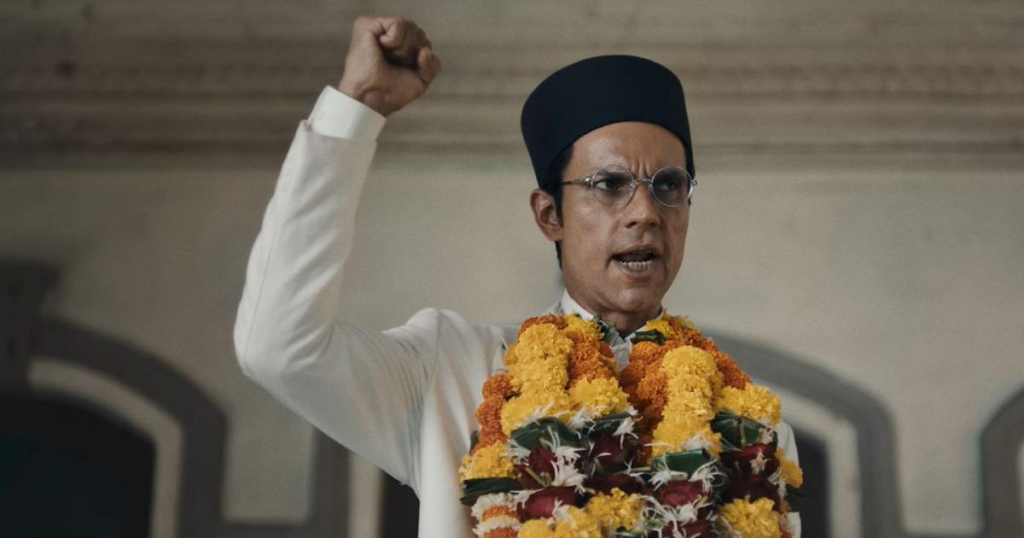Explore below to read the Swatantrya Veer Savarkar movie review. It highlights all the aspects how skillfully Randeep Hooda has made the biopic. Apart, what all things he missed out.
andeep Hooda’s Intense Biopic: A Polarizing Portrayal

Vinayak Damodar Savarkar, one of the most divisive individuals in Indian history, gets an entirely new way of life during the election season. How? Randeep Hooda directs an intense biopic about the Hindutva philosopher. Passion and dedication is clearly shown both in plots and action. This allows Hooda to offer an adaptable ideological spine to the multifaceted person, both loved and hated.
Drawing on inaccuracies, views, and perspectives given by right-wing individuals for nearly a century; the 178-minute simplistic movie unfolds like a series of falsehoods. This portrays Savarkar as the father figure for freedom fighters. The man who considered a violent uprising would bring Indian independence sooner than a nonviolent revolution. It also depicts Congress as the villain, preventing Savarkar from receiving the credit he deserves.
The film does not mention the monthly payment he received from the British government after his release from prison. Further, the movie doesn’t say who gave him the name of Veer (courageous). Hooda has planted a skillfully written puff piece with plenty for the disciples and opponents to chew over. This perfectly fits Savarkar, a man who revelled in self-glorification.
Savarkar’s Complex Legacy

While looking at the divisive figure, the film accurately portrays the youthful Savarkar as a rationalist. The man who enjoyed shellfish and documented the revolt of 1857, which he dubbed the First War of Indian Independence. The Savarkar brothers’ devotion to the nationalist movement. Furthermore, the film presents his efforts to build an ideological foundation for the Free India Society in depth.
However, it undermines Savarkar’s communal turn by deleting historical facts. Alongside, it create new ones, such as imagining a meeting between Savarkar and Bhagat Singh. His boyhood, a personal example about ransacking a mosque, is lacking. This would have clarified his interpretation of the First War of Independence as a communal alliance of Hindus and Muslims against Christians. His partnership with the colonial rulers to outwit the Muslim leadership in the power struggle had a communal undertone. However, the film depicted it as a significant strategic decision rooted in practicality in response to Gandhi’s support for the Khilafat Movement.
In his vision of India, there is no room for communities that do not regard India as their holy place. This keeps resonating in modern India, where political representation for Muslims is declining. The film depicts him being subjected to persistent torture in Kala Pani (Cellular Jail). However, it fails to describe how mainland reforms changed the tone of his mercy petitions.
The film presents Savarkar as someone who is connected to extremists in Congress. It portrays him as someone who motivated young minds. This includes Madanlal Dhingra and Bhagat Singh to Subhas Chandra Bose, to develop a different outlook to free India from the clutches of English. The horrible struggle that he endures in the Cellular Jail causes an emotional outburst. Along the way, the film showcases what may have been attained if the country had not taken the nonviolent road.
The picture of cruelty on him against the scenic beauty of Port Blair threatens to persuade even his harshest opponents. Similarly, the scene in which he returns from Ratnagiri jail after years of imprisonment, expecting a hero’s welcome. However, finding only his elder brother Ganesh waiting for him, symbolizes the churn in his politics. The sadness and desperation in his reaction when he learns that Gandhi had written to masters on his behalf in interim. This highlights what made him envious of Gandhi and Nehru and places him on par with Jinnah. The Hindu Mahasabha and the Muslim League formed a coalition government after the Quit India Movement; the film remains silent.
Also read: Swatantra Veer Savarkar box office collection day 1!
